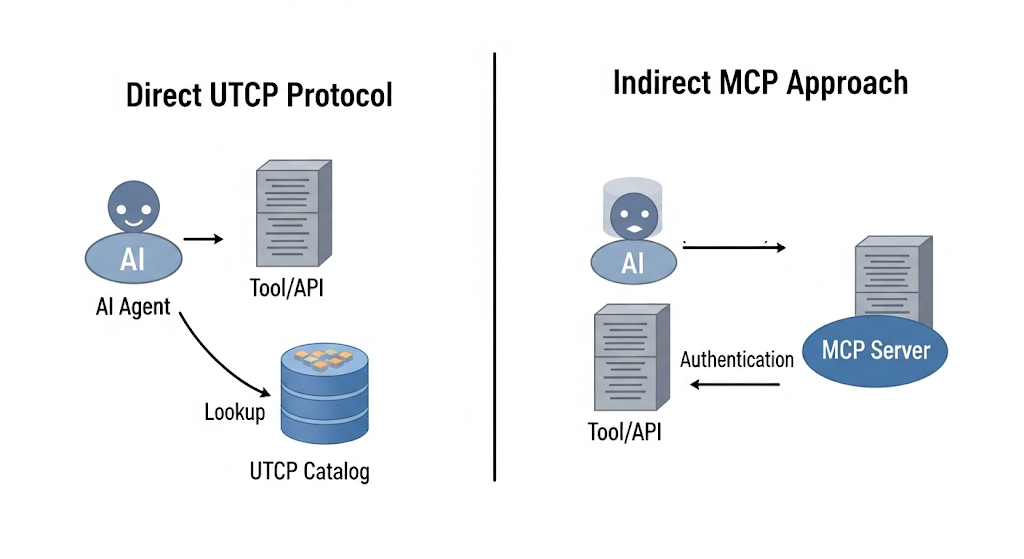The rise of AI agents is reshaping how businesses operate, automating complex workflows and unlocking unprecedented efficiency. But as organizations race to integrate these intelligent agents with their existing systems, a critical question emerges: how do we enable AI agents to seamlessly discover and interact with the vast ecosystem of tools we've spent decades building?
Enter the Universal Tool Calling Protocol (UTCP). It's poised to become the "DNS of the agentic world"—a universal, scalable, and efficient standard for connecting AI agents directly to enterprise systems.
The Pitfall of the Middleman: Understanding the "Wrapper Tax"
An early approach to AI integration, the Model Context Protocol (MCP), relies on a middleman architecture. This protocol requires developers to build and maintain dedicated "MCP Servers" that act as translators between an agent's request and a tool's native API. This creates a "Wrapper Tax" with four key costs:
Development Overhead
Developers are burdened with building and maintaining these intermediary servers, including constant updates whenever a native API changes.
Infrastructure Costs
Each MCP server demands its own compute resources, monitoring, and logging, adding to operational expenses.
Performance Latency
The extra network hop (Agent → MCP Server → API) introduces delays and creates performance bottlenecks.
Expanded Attack Surface
Every middleman server is a new potential point of failure and a target for security threats, increasing vulnerability.
For an enterprise with hundreds or thousands of services, this tax compounds into a significant drain on resources, undermining the very efficiency that AI promises to deliver.
UTCP: Direct, Efficient, and Scalable Discovery
The Universal Tool Calling Protocol (UTCP) takes a radically different approach. It functions as a universal discovery layer—a standardized "manual" that tools use to describe themselves. UTCP provides a catalog where agents can look up a tool's essential information.
The process is simple and direct:
Discovery
An AI agent queries the UTCP catalog to find a tool's native endpoint (e.g., api.mycompany.com/v2/inventory), required protocol (e.g., REST), and authentication method (e.g., OAuth2).
Direct Execution
Armed with this information, the agent interacts directly with the tool's API.
This DNS-like approach delivers transformative benefits:
Zero Wrapper Tax
By eliminating middleman servers, UTCP cuts development, infrastructure, and maintenance costs.
Maximized ROI
UTCP leverages existing investments in scalable and secure APIs, allowing agents to tap directly into decades of hardened enterprise infrastructure.
Instant Legacy Compatibility
From modern gRPC services to 15-year-old SOAP endpoints, any tool can be made agent-accessible by creating a simple UTCP entry—no modernization required.
Enhanced Performance & Security
Direct communication minimizes latency and relies on existing, security-hardened endpoints, avoiding the creation of new vulnerabilities.
When to Use MCP Strategically
The MCP server approach can be beneficial in specific, targeted scenarios:
Abstracting Complexity
For a small number of highly complex or inconsistent legacy systems, a dedicated server can abstract the chaos and present a clean, standardized interface to the agent.
Rapid Third-Party Integration
When integrating an external service where you cannot modify the underlying architecture, a middleman can serve as a quick adapter to make it agent-compatible.
Centralized Control
A server can be used to enforce centralized logic like rate limiting, specialized logging, or custom business rules that you don't want to build into every agent.
The Path Forward: A Hybrid Approach
The future of enterprise AI lies in a smart, frictionless framework that connects agents to tools. The overhead of the "Wrapper Tax" makes MCP unsuitable as a universal solution. Instead, enterprises may adopt UTCP as the primary discovery layer for all tools and strategically using MCP-style servers where they provide clear value.
By doing this, organizations can maximize ROI, streamline operations, and build a future-proof architecture where AI agents navigate the enterprise with ease and efficiency.
